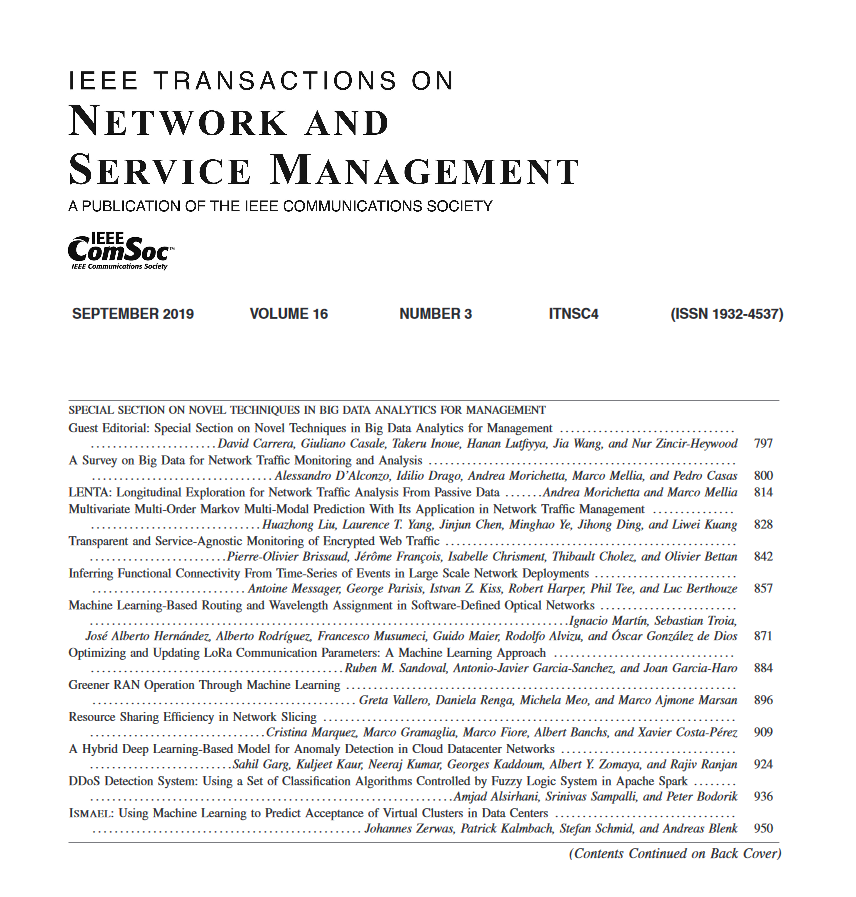Optimizing Traffic Management in Airborne Power Line Communication Networks: A Credit-Based Shaping Approach Using Network Calculus
IF 5.4
2区 计算机科学
Q1 COMPUTER SCIENCE, INFORMATION SYSTEMS
IEEE Transactions on Network and Service Management
Pub Date : 2025-01-16
DOI:10.1109/TNSM.2025.3529871
引用次数: 0
Abstract
As the aviation industry progresses towards More Electric Aircraft (MEA), the demand for robust and efficient data communication systems intensifies. Traditional fieldbus systems are burdened by high installation costs and substantial weight due to extensive cabling requirements. The Power Line Communication (PLC) technology presents a promising alternative; however, its adaptation to the stringent real-time demands of airborne environments poses significant challenges. To address this, this paper introduces a novel Credit-Based Shaper with Channel Contention (CBSCC) mechanism designed to optimize traffic management in airborne PLC networks. This mechanism operates at the Medium Access Control (MAC) layer of the HomePlug AV 2 protocol, employing a dynamic configuration approach informed by Network Calculus (NC). This approach utilizes End-to-End Delay (E2ED) requirements of data flows and network configuration details to calculate the parameters for the CBSCC traffic shaper. Comprehensive simulations conducted with OMNeT++ demonstrate the efficacy of CBSCC, demonstrating marked improvements in E2ED satisfaction for all data frames, reduced average access delays, and enhanced fairness across different priority levels compared to the HomePlug AV2 protocol and previous traffic management strategies. The findings confirm that the CBSCC mechanism substantially alleviates the starvation of lower-priority traffic, boosts network efficiency, and ensures robust real-time guarantees essential for the safety and reliability of airborne communication systems. This research represents a substantial advancement over existing solutions, aligning with the evolving needs of MEA implementations.机载电力线通信网络流量管理优化:基于信用的网络微积分整形方法
随着航空工业向更多的电动飞机(MEA)发展,对强大和高效的数据通信系统的需求加剧。传统的现场总线系统由于布线要求广泛,安装成本高,重量大。电力线通信(PLC)技术是一种很有前途的替代方案;然而,它对机载环境严格的实时性要求的适应提出了重大挑战。为了解决这个问题,本文介绍了一种新颖的基于信用的信道争用(CBSCC)机制,旨在优化机载PLC网络中的流量管理。该机制在HomePlug AV 2协议的介质访问控制(MAC)层运行,采用网络演算(Network Calculus, NC)提供的动态配置方法。该方法利用数据流的端到端延迟(E2ED)需求和网络配置细节来计算CBSCC流量整形器的参数。利用omnet++进行的综合仿真证明了CBSCC的有效性,与HomePlug AV2协议和以前的流量管理策略相比,CBSCC在所有数据帧的E2ED满意度方面有显著改善,减少了平均访问延迟,并增强了不同优先级级别的公平性。研究结果证实,CBSCC机制大大缓解了低优先级流量的饥饿,提高了网络效率,并确保了对机载通信系统的安全性和可靠性至关重要的强大实时性保障。这项研究代表了现有解决方案的实质性进步,与MEA实现的不断发展的需求保持一致。
本文章由计算机程序翻译,如有差异,请以英文原文为准。
求助全文
约1分钟内获得全文
求助全文
来源期刊

IEEE Transactions on Network and Service Management
Computer Science-Computer Networks and Communications
CiteScore
9.30
自引率
15.10%
发文量
325
期刊介绍:
IEEE Transactions on Network and Service Management will publish (online only) peerreviewed archival quality papers that advance the state-of-the-art and practical applications of network and service management. Theoretical research contributions (presenting new concepts and techniques) and applied contributions (reporting on experiences and experiments with actual systems) will be encouraged. These transactions will focus on the key technical issues related to: Management Models, Architectures and Frameworks; Service Provisioning, Reliability and Quality Assurance; Management Functions; Enabling Technologies; Information and Communication Models; Policies; Applications and Case Studies; Emerging Technologies and Standards.
 求助内容:
求助内容: 应助结果提醒方式:
应助结果提醒方式:


